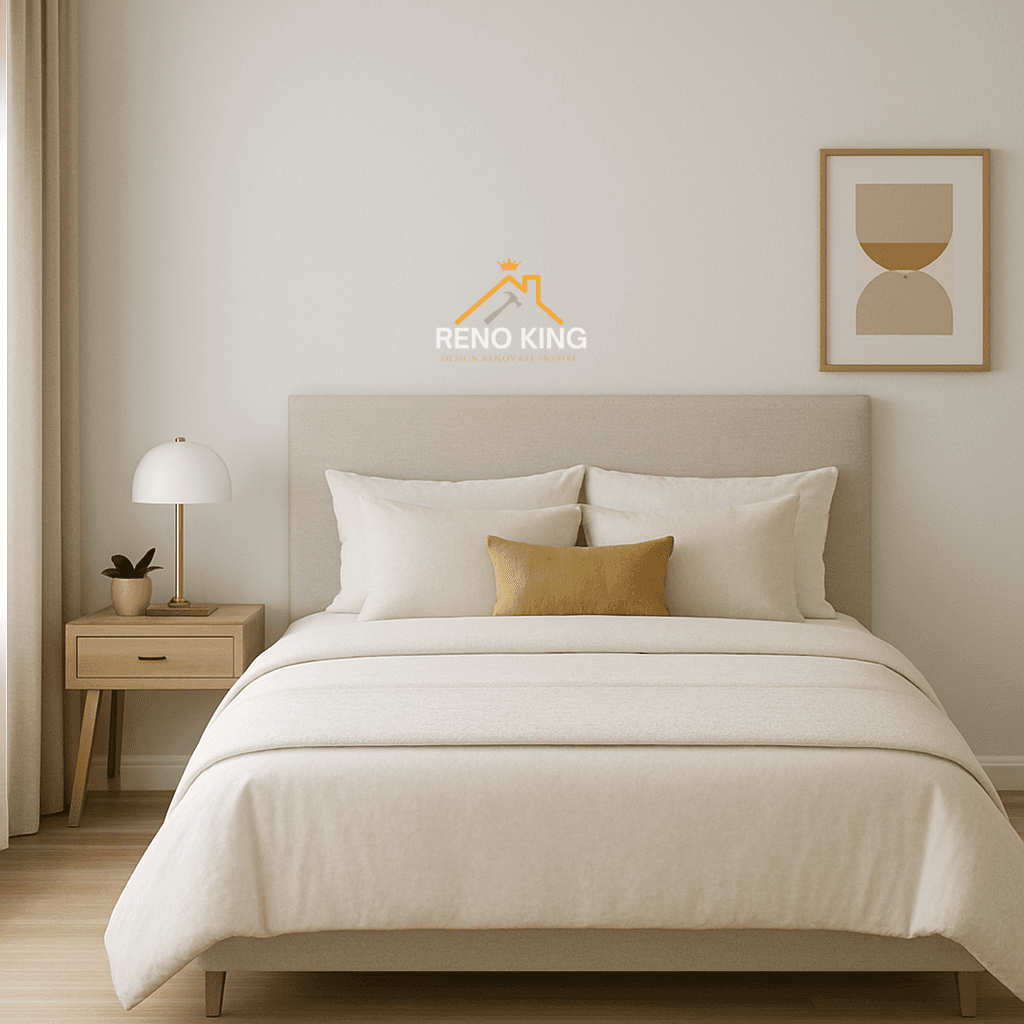Monday, August 25, 2025
Introduction: The Transformative Power of Color in Your Personal Sanctuary
Have you ever walked into a room and immediately felt a shift in your mood? Perhaps you entered a space that made you feel instantly calm and relaxed, or maybe you found yourself in an environment that left you feeling agitated or uncomfortable without understanding why. Often, these powerful emotional responses are triggered not by the furniture or architecture alone, but by the colors that surround you.
Color psychology—the study of how different hues affect human behavior, emotions, and mental processes—is far more than just a design trend. It’s a scientifically-grounded approach to creating environments that actively support your well-being. When applied thoughtfully to your bedroom renovation, color psychology can transform your space from a simple sleeping area into a personalized sanctuary that promotes better sleep, reduces stress, and supports your emotional health.
In our busy Calgary lives, where winter darkness and summer busyness can both take their toll, creating a bedroom that actively supports your well-being isn’t a luxury—it’s a necessity. This comprehensive guide will take you deep into the world of color psychology, providing you with the knowledge and tools you need to make intentional color choices that will transform not just your space, but how you feel within it.
The Science Behind Color Psychology: Understanding Why Colors Affect Us
Biological Responses to Color
The connection between color and emotion isn’t just metaphorical or cultural—it’s rooted in our biology. Different colors actually produce measurable physiological responses:
Warm Colors (Reds, Oranges, Yellows):
- Stimulate the nervous system
- Increase heart rate and blood pressure
- Boost energy levels and appetite
- Trigger the release of adrenaline
Cool Colors (Blues, Greens, Purples):
- Calm the nervous system
- Lower heart rate and blood pressure
- Reduce anxiety and stress hormones
- Promote feelings of peace and relaxation
Neutral Colors (Whites, Grays, Browns, Blacks):
- Create visual rest and balance
- Allow other colors to stand out
- Provide a sense of stability and grounding
This biological wiring explains why we might feel agitated in a bright red room but calm in a soft blue space. It’s not just in our heads—it’s in our bodies.
Cultural and Personal Associations
While biological responses form the foundation of color psychology, our personal and cultural experiences also shape how we perceive colors. For example:
- In Western cultures, white often represents purity and cleanliness, while in some Eastern cultures it’s associated with mourning
- Red might signify danger or excitement to one person, but remind another of their grandmother’s cozy kitchen
- Green might represent nature and growth to some, while triggering envy in others
The most successful bedroom color schemes consider both the universal effects of color and your personal associations and preferences.
Comprehensive Color Guide: Choosing the Right Hues for Your Needs
The Calming Palette: Colors for Rest and Relaxation
Serene Blues: The Ultimate Bedroom Color
Blue is consistently ranked as the most popular bedroom color for good reason. Research has shown that blue environments can lower blood pressure by up to 8 points, reduce heart rate, and even decrease the production of stress hormones.
Best Blue Shades for Bedrooms:
- Soft Sky Blue (#87CEEB): Creates an airy, open feeling perfect for smaller rooms or spaces with limited natural light
- Dusty Blue (#6699CC): Offers the calming properties of blue with added warmth that prevents the space from feeling cold
- Steel Blue (#4682B4): Provides a sophisticated, grounded feeling that works well in contemporary spaces
- Navy Blue (#000080): Excellent as an accent color for creating depth and drama without overwhelming the space
Calgary-Specific Tip: Given our long winters and north-facing rooms that can feel particularly cold, choose blue shades with gray or green undertones rather than pure blues, which can feel chilly in limited light.
Restful Greens: Bringing Nature Indoors
Green represents balance, harmony, and renewal—making it perfect for a space where you both rest and begin your day. Being in the middle of the color spectrum, green is the easiest color for our eyes to process, reducing eye strain and mental fatigue.
Best Green Shades for Bedrooms:
- Sage Green (#9DC183): This soft, earthy green promotes tranquility and connection to nature
- Seafoam Green (#93E9BE): Fresh and airy, perfect for creating a spa-like atmosphere
- Olive Green (#6B8E23): Rich and warm, creates a cocooning effect that feels both secure and sophisticated
- Pistachio (#93C572): Light and cheerful without being overwhelming, great for rooms that need an energy boost
Soothing Neutrals: The Foundation of Calm
Neutral colors provide the perfect backdrop for a restful environment, creating visual rest and allowing other elements to shine.
Best Neutral Strategies:
- Warm Whites: Choose options with beige, cream, or pink undertones like Swiss Coffee (#DBD0C0) or White Dove (#F3F0E9)
- Soft Grays: Look for greige (gray-beige) options like Repose Gray (#E6E3E0) for maximum warmth
- Taupe (#8B8589): A perfect balance between brown and gray that provides warmth without darkness
- Oyster (#E3DFD2): A sophisticated off-white that works in any light condition
The Energizing Palette: Colors for Morning Vitality
While your bedroom should primarily support rest, strategic use of energizing colors can help you start your day feeling positive and motivated.
Sunny Yellows: Happiness in Small Doses
Yellow stimulates happiness, creativity, and optimism but can be overwhelming in large amounts. It’s best used as an accent color rather than a main wall color.
Best Uses for Yellow:
- Throw pillows and blankets in mustard (#E1AD01) or goldenrod (#DAA520)
- Artwork and decorative objects that add pops of cheerfulness
- A single accent wall that gets morning light in soft butter yellow (#FCE883)
Soft Peach and Coral: Warmth Without Overstimulation
These pink-orange shades provide warmth and energy without the intensity of brighter colors.
How to Use Them:
- Bed linens and window treatments in apricot (#FBCEB1) or coral (#FF7F50)
- An accent chair or ottoman that adds visual interest
- Wall color in a reading nook within the bedroom using peach (#FFE5B4)
The Romantic Palette: Creating Intimacy and Connection
Certain colors naturally foster feelings of romance, intimacy, and comfort—perfect for a master bedroom.
Dusty Roses and Blush Pinks
These soft pink tones create a gentle, nurturing environment that feels both romantic and relaxing.
Implementation Ideas:
- Feature wall behind the bed in blush pink (#DE98A8) or dusty rose (#C9A59C)
- Upholstered headboard in velvet rose (#B76E79)
- Luxurious bedding sets that add softness and romance
Deep Reds and Burgundies
Rich red tones stimulate passion and energy but should be used sparingly in bedrooms.
Strategic Uses:
- Accent wall in very large bedrooms using burgundy (#800020) or oxblood (#4A0000)
- Decorative accessories like vases or picture frames
- Darkened reds in matte finish to reduce intensity while maintaining richness
The 60-30-10 Rule: A Designer’s Formula for Perfect Color Balance
This timeless design principle provides a foolproof framework for creating a balanced, harmonious color scheme that feels intentional and professionally designed.
Understanding the Formula
- 60% Dominant Color: This is your main wall color, the foundation that sets the tone for the entire room
- 30% Secondary Color: Used for larger furniture pieces, area rugs, and window treatments
- 10% Accent Color: Reserved for decorative accessories, artwork, and small touches that add personality
Practical Application Example
- 60%: Soft blue-gray walls (Benjamin Moore Hale Navy #HC-154)
- 30%: White furniture and light wood tones (bed frame, dresser, nightstands)
- 10%: Coral accents in throw pillows, artwork, and decorative objects
Advanced Application: The 60-30-10-5 Variation
For more sophisticated spaces, consider adding a fourth color at 5% for additional depth:
- 60%: Main color
- 30%: Secondary color
- 10%: First accent color
- 5%: Metallic accent (gold, brass, or silver)
Considering Your Room’s Specific Conditions
Lighting Conditions: The Game Changer
The same color can look dramatically different depending on the light in your room. This is especially important in Calgary, where light conditions vary dramatically between seasons.
North-Facing Rooms:
- Receive cooler, bluer light throughout the day
- Benefit from warm colors with yellow or red undertones
- Avoid cool grays and blues that might feel chilly
- Recommended colors: Warm whites, soft yellows, warm grays
South-Facing Rooms:
- Receive warm, yellow light throughout the day
- Can handle cooler colors without feeling cold
- Bright colors might become overly intense in direct sunlight
- Recommended colors: Cool blues, greens, true grays
East-Facing Rooms:
- Receive warm yellow light in the morning, cooler blue light in the afternoon
- Need versatile colors that work in both warm and cool light
- Recommended colors: Balanced neutrals, flexible greens
West-Facing Rooms:
- Receive cooler light in the morning, warm golden light in the afternoon
- Can handle both warm and cool colors depending on usage
- Recommended colors: Warm neutrals, flexible blues
Room Size and Layout Considerations
Small Bedrooms:
- Light colors make spaces feel larger and airier
- Consistent color on walls, ceiling, and trim expands the space visually
- Glossy finishes reflect more light and enhance the sense of space
- Recommended approach: Monochromatic schemes, light colors, high-gloss trim
Large Bedrooms:
- Can handle darker, more saturated colors
- Different wall colors can define areas within the room (sleeping area, sitting area, etc.)
- Matte finishes help absorb light and create intimacy
- Recommended approach: Feature walls, color zoning, rich saturated colors
Low Ceilings:
- Painting ceilings slightly lighter than walls creates the illusion of height
- Vertical stripes or patterns can enhance the sense of height
- Recommended approach: Light ceiling colors, vertical design elements
Calgary-Specific Color Considerations
Our unique climate and architectural features present specific challenges and opportunities for bedroom color choices.
Addressing Our Long Winters
During our gray winter months, the colors in your bedroom can significantly impact your mood and mental health.
Strategies for Winter:
- Choose colors with warm undertones to combat the grayness outside
- Consider a feature wall in a rich, comforting color like deep green or navy
- Use textured fabrics (velvet, wool, chunky knit) to add visual interest when light is limited
- Incorporate metallic accents (gold, brass) to reflect what little light is available
Maximizing Limited Daylight
Many Calgary bedrooms, especially in older homes, have smaller windows that limit natural light.
Color Solutions for Low Light:
- Light, reflective colors to bounce available light around the room
- Glossy paint sheens (eggshell, satin) to increase light reflection
- Strategic mirror placement opposite windows to maximize light
- Sheer window treatments that allow maximum light penetration
Complementing Calgary’s Natural Landscape
Our beautiful natural environment—from the prairies to the mountains—can inspire beautiful color palettes.
Local-Inspired Palettes:
- Mountain Inspired: Stone grays, forest greens, sky blues
- Prairie Inspired: Wheat golds, sunset oranges, big sky blues
- Urban Inspired: Concrete grays, brick reds, steel blues
Beyond the Walls: Incorporating Color Through Other Elements
You don’t have to paint your walls to benefit from color psychology. These alternative approaches can be equally effective and more flexible.
Bedding and Textiles
- White or neutral bedding with colorful accent pillows allows for easy seasonal changes
- Layered textiles in complementary colors add depth and interest
- Seasonal rotations let you match your bedroom’s energy to the time of year
Furniture and Flooring
- Statement furniture piece in an accent color anchors the room
- Area rugs define the color scheme and create visual boundaries
- Window treatments frame views and control light while adding color
Art and Accessories
- Artwork sets the emotional tone and provides focal points
- Decorative objects add pops of color and personality
- Lighting fixtures complement your color scheme while providing functional light
Plants and Natural Elements
- Live plants add natural green tones and improve air quality
- Fresh flowers provide seasonal color and natural beauty
- Natural materials (wood, stone, wool) add texture and warmth
Colors to Approach with Caution
While personal preference should always be your primary guide, some colors present specific challenges in bedroom settings.
Bright Reds
- Can increase heart rate and blood pressure
- May make it difficult to relax and fall asleep
- Best used as very small accents rather than main colors
- Alternative: Deep burgundy or terracotta
Vibrant Oranges
- Highly energizing and stimulating
- Can feel overwhelming in a restful space
- Alternative: Soft peach, apricot, or terracotta
Pure Black
- Can make rooms feel small and cave-like
- May contribute to feelings of sadness or heaviness
- Alternative: Very dark gray, charcoal, or navy blue
Neon Brights
- Overstimulating to the nervous system
- Difficult to create a restful atmosphere
- Alternative: Muted versions of bright colors
Putting It All Together: Creating Your Personalized Color Plan
Step 1: Identify Your Primary Goals
What do you most want to feel in your bedroom?
- Peaceful and rested
- Energized and motivated
- Romantic and connected
- Creative and inspired
- Safe and secure
Step 2: Assess Your Room’s Conditions
- Evaluate natural light sources and directions
- Note the size, layout, and architectural features
- Consider existing fixed elements (flooring, built-ins)
- Identify any challenges (low light, small size, etc.)
Step 3: Choose Your Color Family
Select 2-3 main colors based on your goals and room conditions, using the 60-30-10 rule as guidance.
Step 4: Test Your Colors
- Get sample pots and paint large swatches (2’x2′ minimum)
- View colors at different times of day and under artificial light
- Live with them for several days before making final decisions
- Observe how colors make you feel at different times
Step 5: Implement Your Scheme
- Start with walls, then add larger furniture pieces
- Layer in textiles and soft furnishings
- Finish with decorative accents and personal touches
- Allow yourself flexibility to adjust as you live with the space
Need Professional Guidance Bringing Your Vision to Life?
Choosing the right colors for your bedroom renovation involves balancing many factors—from the scientific effects of different hues to your personal preferences and your room’s specific conditions. While this guide provides comprehensive information, implementing these ideas successfully often benefits from professional expertise.
At Reno King, we’ve helped countless Calgary homeowners create beautiful, personalized bedrooms that perfectly balance aesthetic appeal with psychological comfort. Our design team brings:
- Local expertise understanding Calgary’s unique light conditions and climate challenges
- Technical knowledge of how colors interact with different surfaces and lighting
- Practical experience implementing color schemes that work in real homes
- Professional resources including color consultation tools and sampling options
We can help you:
- Select colors that work with your specific light conditions
- Create a complete color scheme that reflects your personality and needs
- Coordinate your entire renovation for seamless implementation
- Avoid common color mistakes that can undermine your investment
Ready to create the bedroom of your dreams—a space that not only looks beautiful but feels exactly right?
📞 Contact us today for a consultation and let’s discuss how we can transform your space into the sanctuary you deserve.




